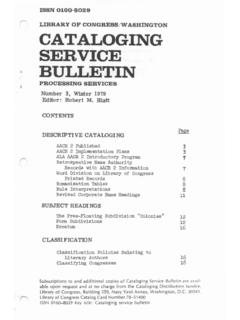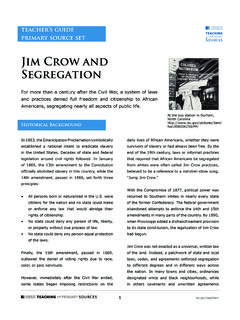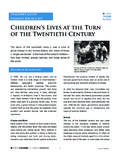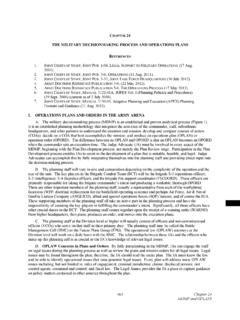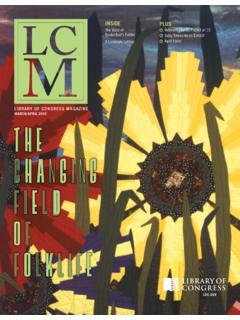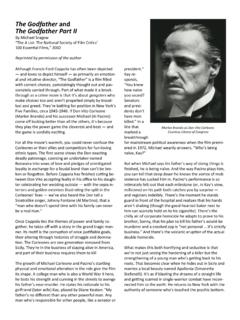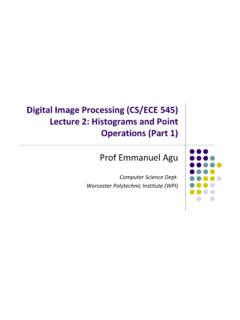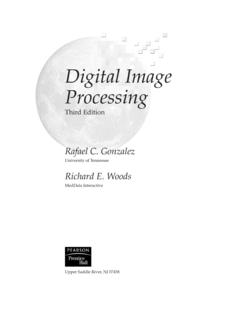Transcription of Introduction to Basic Measures of a Digital Image …
1 - page 1 of 8- Introduction to Basic Measures of a Digital Image for Pictorial Collections Kit A. Peterson, Digital Conversion Specialist, June 2005 Prints & Photographs Division, Library of Congress, Washington, 20540-4730 Introduction This tip sheet introduces the technical structure of a Digital Image and explains the Measures for Digital Image characteristics. The focus is on images created by digitizing photographs, including negatives, transparencies, and prints. Understanding Digital Image elements can help you plan effective scanning services and create rich Digital master1 images. The process of capturing a rich Digital master Image that achieves Best Practice standards in the categories noted here depends upon a variety of factors including: quality of the equipment and software, quality control processes, operator skill, and technical and administrative support throughout the process, including management of the Digital Image and its metadata once the Digital Image is created.
2 Consulting current standards2 can provide the information necessary to establish a system for the digitization of photographs. Once a system is in place, benchmarking the capabilities (and understanding the limitations) of that system through testing and exploration by using targets and a sampling of representative materials will better insure a quality result in the Digital images that are created. Example: See Steven Puglia, Jeffrey Reed and Erin Rhodes. Technical Guidelines for Digitizing Archival Materials for Electronic Access: Creation of Production Master Files Raster Images (Washington, : National Archives and Records Administration, 2004) The tip sheet is organized in six sections: What is a Digital Image ?
3 Two Basic Measures o Spatial resolution o Tonal resolution Tonal mapping Management: File Format & Metadata Related Resources Color systems and terminology What is a Digital Image ? A Digital Image is an electronic file that forms into square picture elements (pixels) when displayed on a viewing device ( , a computer monitor). The displayed Image is a two-dimensional matrix of thousands or millions of pixels each of which has its own address, size, and color representation. You might think of pixels as serving a role similar to the grains in a Digitizing a photograph means converting or capturing its Image electronically through a scanner or Digital camera. Digital Image processing software allows you to magnify an 1 The phrase rich Digital master refers to a Digital Image of sufficiently high quality to capture the essential physical and subjective visual elements of an original photograph.
4 Such Digital masters may be used for high resolution electronic or print reproduction and for creation of derivative files that aid reference and access. Rich Digital masters also facilitate preservation of the Digital images as electronic surrogates of the original photographs. 2 For additional information and a list of resources for establishing quality control in the creation of rich Digital masters, see Library of Congress, Prints and Photographs Division Standards Related to Digital Imaging of Pictorial Materials, 3 Steven Puglia, Technical Primer, in Handbook for Digital Projects: A Management Tool for Preservation and Access, ed. Maxine K. Sitts (Andover, MA: Northeast Document Conservation Center, 2000), 84.
5 Also available online at (hereafter cited as NEDCC Handbook). - page 2 of 8- Image to see the pixels, and to sometimes measure the numeric color values for each pixel like a sophisticated, computer generated, paint-by-number matrix. People use Digital images in many ways. The same Image can be viewed on a wide variety of monitors, printed in many formats, and transmitted electronically through e-mails, cell phones, and other systems. Digital images are stored electronically on media such as computer hard drives, CDs, DVDs, or magnetic tapes. Terminology: dpi and ppi The abbreviation dpi (dots per inch) is a printing term that describes the number of dots in a print. This kind of measure is quite different from the square pixels per inch ( ppi ) displayed in the Digital Image itself.
6 Nonetheless, dpi has been commonly adopted to describe the resolution of Digital images as well, and dpi is used here in place of ppi . Two Basic Measures There are two Basic Measures for Digital Image characteristics: spatial resolution capturing detail (dpi) tonal resolution color, bit-depth, and dynamic range The specifications selected for each measure determine the amount of electronic information captured to represent the original photograph. Generally, the higher the values are within these two categories, the more data will be captured representing a greater amount of photographic detail from the original. Example: To use an analogy with black-and-white copy photography: an 8 x 10 in.
7 Copy negative of a photographic print will contain more information and have greater reproductive versatility than a 35 mm copy negative of the same print. A 20 MB (megabyte) grayscale, rich Digital master Image will contain more information and have greater reproductive versatility than a 20 KB (kilobyte) compressed thumbnail version of the same photograph. Generally, higher spatial, tonal, and color values result in larger file sizes which give your rich Digital master Image a greater versatility for print and display. As with copy negatives, however, size alone does not equal quality. The quality of the source Image and the capabilities of the equipment and the equipment operator also play roles in the quality of the resulting Digital Image .
8 Quality of the original object vs. quality of the Digital Image The quality of the source photograph is the foundation of the Digital Image copy. If the source Image is poor quality ( , out of focus), the quality of your Digital Image will be limited. A poor quality Digital Image can be made from a good quality source photograph. But a good quality Digital Image cannot create values unobtainable from an original source 4 One exception is deteriorated negatives, such as channeled film. Digitizing can sometimes make it possible to capture information from an otherwise unprintable Image and preserve it before the negative deteriorates further.
9 Example: Scans of negatives by Arnold Genthe described in Prints & Photographs Online Catalog, Prints & Photographs Division, Library of Congress, Deterioration and Preservation of Negatives, Autochromes and Lantern Slides, - page 3 of 8- Spatial Resolution (Spatial Frequency/dpi) Spatial resolution is the rate at which an Image is sampled during scanning. More specifically it is the frequency of pixels used to capture sample tones in the space of the object being digitized ( , 300 pixels per inch of the original, or 500 pixels per inch of the original). Generally, more pixels per inch means a higher resolution, but overall Image quality cannot be determined by spatial resolution alone.
10 Spatial frequency is a synonym for spatial resolution. For a summary of sample technical specifications from nine institutions, see Library of Congress, Prints and Photographs Division, Digital Master Images: Sample Technical Specifications for Photograph Collections, There s More to High Resolution Than DPI. A common mistake with Digital images is to use dpi alone as the measure of whether an Image is high or low resolution. Whether an Image is high or low resolution actually depends upon the combination of the size (height x width) of the original object, the dpi sampling rate used to create the Digital Image , and the ultimate presentation or reproduction uses for the Digital Image .
